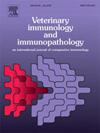Revisiting tribromoethanol as a safe and effective murine anesthetic for veterinary clinical and biomedical research
IF 1.4
3区 农林科学
Q4 IMMUNOLOGY
引用次数: 0
Abstract
Mus musculus, the house mouse, is the most widely used mammalian model in biomedical research. Mice frequently undergo injectable anesthesia for numerous research procedures, with the most common anesthetic protocol being ketamine-xylazine (K/X). 2,2,2-Tribromoethanol (TBE), a non-regulated chemical, is also used, but has been linked to peritonitis. The focus of this study was to directly compare these two anesthetic protocols by evaluating induction rates, recovery times, organ weight data, and immune endpoints. Forty-five CD-1 female (8–10 week-old) mice were divided into three experiments. Two anesthetic events were performed 2 weeks apart. For each experiment, mice received an intraperitoneal (IP) injection of sterile phosphate buffered saline, (PBS; n = 3 mice), an IP injection of K/X (n = 6 mice), or an IP injection of sterile TBE (n = 6 mice). In a separate third anesthetic event (n = 5 mice/treatment), post-treatment peripheral blood and peritoneal lavage samples were collected for a 9-plex cytokine analysis. Mice were euthanized 2 weeks after the last anesthetic event. Induction rates were non-significantly but numerically more rapid with TBE as compared to K/X, at 2.7 ± 0.6 min and 4.0 ± 0.7 min, respectively. TBE mice had significantly more rapid recovery time (∼25 min) compared to K/X (∼50 min), which also had 50 % anesthetic mortalities. Organ weight ratios, immune phenotype, cytology, serum and peritoneal lavage cytokine levels, and histopathology were unremarkable. TBE performed better and more safely as a murine anesthetic for light anesthesia compared to K/X based on recovery times, no mortalities, and an absence of local and systemic inflammation.
重新探讨三溴乙醇作为一种安全有效的小鼠麻醉剂用于兽医临床和生物医学研究
小家鼠是生物医学研究中应用最广泛的哺乳动物模型。在许多研究过程中,小鼠经常接受注射麻醉,最常见的麻醉方案是氯胺酮-二嗪(K/X)。2,2,2-三溴乙醇(TBE),一种不受管制的化学物质,也被使用,但与腹膜炎有关。本研究的重点是通过评估诱导率、恢复时间、器官重量数据和免疫终点来直接比较这两种麻醉方案。45只CD-1雌性(8-10周龄)小鼠分为3个实验。两次麻醉事件间隔2周进行。在每个实验中,小鼠腹腔注射无菌磷酸盐缓冲盐水(PBS);n = 3只小鼠),IP注射K/X (n = 6只小鼠),或IP注射无菌TBE (n = 6只小鼠)。在单独的第三次麻醉事件(n = 5只小鼠/治疗)中,收集治疗后外周血和腹腔灌洗液样本进行9-plex细胞因子分析。在最后一次麻醉后2周对小鼠实施安乐死。与K/X相比,TBE的诱导率无显著性,但在数值上更快,分别为2.7±0.6 min和4.0 ± 0.7 min。与K/X(~ 50 min)相比,be小鼠的恢复时间(~ 25 min)明显更快,K/X也有50% %的麻醉死亡率。器官重量比、免疫表型、细胞学、血清和腹腔灌洗细胞因子水平以及组织病理学均无显著差异。基于恢复时间、无死亡、无局部和全身炎症,与K/X相比,TBE作为轻麻醉的小鼠麻醉剂表现更好、更安全。
本文章由计算机程序翻译,如有差异,请以英文原文为准。
求助全文
约1分钟内获得全文
求助全文
来源期刊
CiteScore
3.40
自引率
5.60%
发文量
79
审稿时长
70 days
期刊介绍:
The journal reports basic, comparative and clinical immunology as they pertain to the animal species designated here: livestock, poultry, and fish species that are major food animals and companion animals such as cats, dogs, horses and camels, and wildlife species that act as reservoirs for food, companion or human infectious diseases, or as models for human disease.
Rodent models of infectious diseases that are of importance in the animal species indicated above,when the disease requires a level of containment that is not readily available for larger animal experimentation (ABSL3), will be considered. Papers on rabbits, lizards, guinea pigs, badgers, armadillos, elephants, antelope, and buffalo will be reviewed if the research advances our fundamental understanding of immunology, or if they act as a reservoir of infectious disease for the primary animal species designated above, or for humans. Manuscripts employing other species will be reviewed if justified as fitting into the categories above.
The following topics are appropriate: biology of cells and mechanisms of the immune system, immunochemistry, immunodeficiencies, immunodiagnosis, immunogenetics, immunopathology, immunology of infectious disease and tumors, immunoprophylaxis including vaccine development and delivery, immunological aspects of pregnancy including passive immunity, autoimmuity, neuroimmunology, and transplanatation immunology. Manuscripts that describe new genes and development of tools such as monoclonal antibodies are also of interest when part of a larger biological study. Studies employing extracts or constituents (plant extracts, feed additives or microbiome) must be sufficiently defined to be reproduced in other laboratories and also provide evidence for possible mechanisms and not simply show an effect on the immune system.

 求助内容:
求助内容: 应助结果提醒方式:
应助结果提醒方式:


